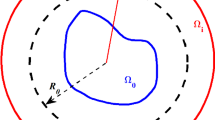Abstract
Motivated by numerical methods for solving parametric partial differential equations, this paper studies the approximation of multivariate analytic functions by algebraic polynomials. We introduce various anisotropic model classes based on Taylor expansions, and study their approximation by finite dimensional polynomial spaces \({{\mathcal {P}}}_\Lambda \) described by lower sets \(\Lambda \). Given a budget n for the dimension of \({{\mathcal {P}}}_\Lambda \), we prove that certain lower sets \(\Lambda _n\), with cardinality n, provide a certifiable approximation error that is in a certain sense optimal, and that these lower sets have a simple definition in terms of simplices. Our main goal is to obtain approximation results when the number of variables d is large and even infinite, and so we concentrate almost exclusively on the case \(d=\infty \). We also emphasize obtaining results which hold for the full range \(n\ge 1\), rather than asymptotic results that only hold for n sufficiently large. In applications, one typically wants n small to comply with computational budgets.


Similar content being viewed by others
References
Bachmayr, M., Cohen, A., Migliorati, G.: Sparse polynomial approximation of parametric elliptic PDEs. Part I: affine coefficients. ESAIM: Math. Modell. Numer. Anal. 51(1), 321–339 (2017)
Beck, J., Nobile, F., Tamellini, L., Tempone, R.: On the optimal polynomial approximation of stochastic PDEs by Galerkin and collocation methods. Math. Models Methods Appl. Sci. 22(9), 1250023 (2012)
Beck, J., Nobile, F., Tamellini, L., Tempone, R.: Convergence of quasi-optimal Stochastic Galerkin methods for a class of PDES with random coefficients. Comput. Math. Appl. 67(4), 732–751 (2014)
Beged-Dov, A.: Lower and upper bounds for the number of lattice points in a simplex. SIAM J. Appl. Math. 22(1), 106–108 (1972)
Bieri, M., Andreev, R., Schwab, C.: Sparse tensor discretizations of elliptic SPDEs. SIAM J. Sci. Comput. 31(6), 4281–4304 (2009)
Binev, P., Dahmen, W., DeVore, R.: Adaptive finite element methods with convergence rates. Numerische Mathematik 97(2), 219–268 (2004)
Binev, P., Dahmen, W., DeVore, R., Petrushev, P.: Approximation classes for adaptive methods. Serdica Math. J. 28(4), 391–416 (2002)
Bonito, A., DeVore, R., Nochetto, R.: Adaptive finite element methods for elliptic problems with discontinuous coefficients. SIAM J. Numer. Anal. 51(6), 3106–3134 (2013)
Brenner, S., Scott, R.: The Mathematical Theory of Finite Element Methods, vol. 15. Springer, Berlin (2007)
Canfield, E., Erdös, P., Pomerance, C.: On a problem of Oppenheim concerning “factorisatio numerorum”. J. Number Theory 17(1), 1–28 (1983)
Chkifa, A., Cohen, A., DeVore, R., Schwab, C.: Sparse adaptive Taylor approximation algorithms for parametric and stochastic elliptic PDEs. ESAIM: Math. Modell. Numer. Anal. 47(1), 253–280 (2013)
Chkifa, A., Cohen, A., Schwab, C.: Breaking the curse of dimensionality in sparse polynomial approximation of parametric PDEs. J. Math. Pures Appl. 9(2), 400–428 (2015)
Cohen, A., DeVore, R.: Approximation of high-dimensional parametric PDEs. Acta Numer. 24, 1–159 (2015)
Cohen, A., DeVore, R., Schwab, C.: Analytic regularity and polynomial approximation of parametric stochastic elliptic PDEs. Anal. Appl. 9(1), 11–47 (2011)
Cohen, A., Migliorati, G.: Multivariate approximation in downward closed polynomial spaces. In: Contemporary Computational Mathematics—A Celebration of the 80th Birthday of Ian Sloan, Vols 1 and 2, pp. 233–282. Springer, Cham (2018)
de Azevedo Pribitkin, W.: Simple upper bounds for partition functions. Ramanujan J. 18(1), 113–119 (2009)
Griebel, M., Oettershagen, J.: On tensor product approximation of analytic functions. J. Approx. Theory 207, 348–379 (2016)
Luca, F., Mukhopadhyay, A., Srinivas, K.: Some results on Oppenheim’s “Factorisatio Numerorum” function. Acta Arithmetica 142, 41–50 (2010)
Riordan, J.: An Introduction to Combinatorial Analysis. Princeton University Press, Princeton (1978)
Tran, H., Webster, C., Zhang, G.: Analysis of quasi-optimal polynomial approximations for parameterized PDEs with deterministic and stochastic coefficients. Numer. Math. 137(2), 451–493 (2017)
Yau, S., Zhang, L.: An upper estimate of integral points in real simplices with an application to singularity theory. Math. Res. Lett. 13(5), 911–921 (2006)
Zech, J.: Sparse-grid approximation of high-dimensional parametric PDEs. PhD Thesis, 25683: ETH Zürich (2018) https://doi.org/10.3929/ethz-b-000340651
Author information
Authors and Affiliations
Corresponding author
Additional information
Communicated by Albert Cohen.
Publisher's Note
Springer Nature remains neutral with regard to jurisdictional claims in published maps and institutional affiliations.
This research was supported by the NSF Grants DMS-1817691 (AB), DMS 15-21067 (RD-GP), DMS 18-17603 (RD-GP), ONR Grants N00014-17-1-2908 (RD), N00014-16-1-2706 (RD); DG was supported by the Swiss National Science Foundation Grant P2ELP2-175056 and IAMCS at TAMU, and PJ was supported by an NSF Fellowship DMS-1704121. A portion of this research was completed while RD (Simon Fellow), DG, and PJ were supported as visitors of the Isaac Newton Institute at Cambridge University.
Appendix: Proofs of Corollaries 5.6 and 5.7
Appendix: Proofs of Corollaries 5.6 and 5.7
Proof of Corollary 5.6:
Let \(m=m(n)\) be the largest natural number satisfying (5.14). One can check that for \(n\ge 2^{16}\), we have \(m(n)\ge 6\), and thus it follows from (ii) of Lemma 5.3 that
which gives \(\delta _n(\rho ^*(s)) \le 2^{-m(n)s}\), and thus \(E_n({{\mathcal {U}}}_{\rho ^*(s),1}) \le 2^{-m(n)s}\). \(\square \)
Proof of Corollary 5.7:
To show (5.15), we proceed as follows. We consider first the case \(n=2^k\), \(k\ge 16\). Let m be the largest non-negative natural number satisfying
and let \(\beta \) be defined by the equation \(m=k-\beta \sqrt{k}\). Since \(k\ge 16\), the largest m that satisfies the above estimate is greater or equal to 6. Moreover, we can easily show that \(\beta \le c\). Therefore, we use the fact that \(m=k-\beta \sqrt{k}\ge k-c\sqrt{k}\) and that \(k-c\sqrt{k}\ge (1-c/4) k\) for \(k\ge 16\), which gives
Thus if \(C_1:=\log _2 C\), we have
It follows (since \(m\ge 6\)) that
Therefore, (5.7) and the monotonicity of the sequence \((\delta _n(\rho ^*(s)))_{n\ge 1}\) give
which, according to Remark 5.2, leads to
Now, if \(k\ge 16\) is such that \(2^k\le n<2^{k+1}\), it follows that
which is (5.15). \(\square \)
Rights and permissions
About this article
Cite this article
Bonito, A., DeVore, R., Guignard, D. et al. Polynomial Approximation of Anisotropic Analytic Functions of Several Variables. Constr Approx 53, 319–348 (2021). https://doi.org/10.1007/s00365-020-09511-4
Received:
Revised:
Accepted:
Published:
Issue Date:
DOI: https://doi.org/10.1007/s00365-020-09511-4




